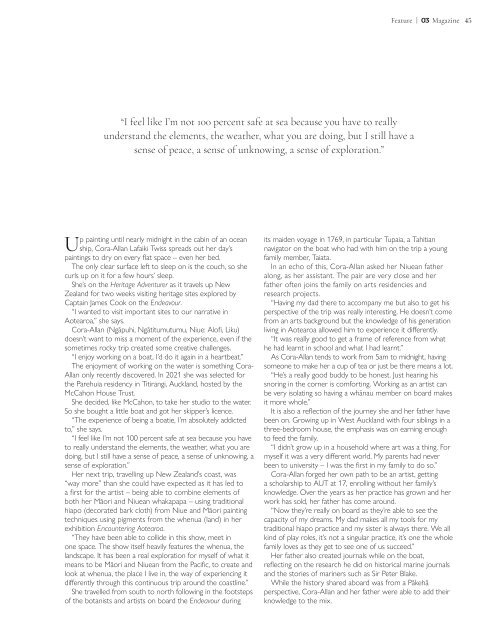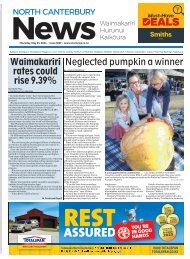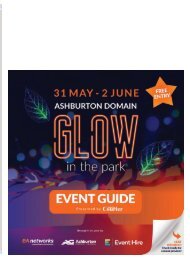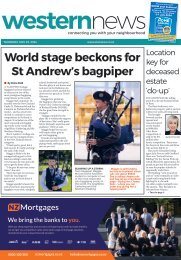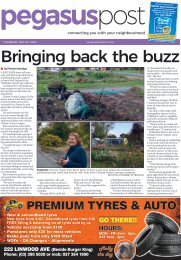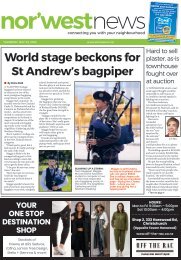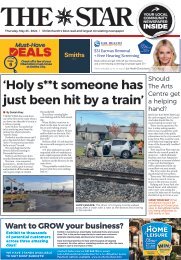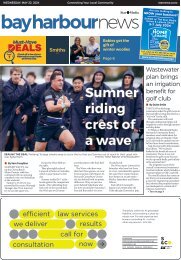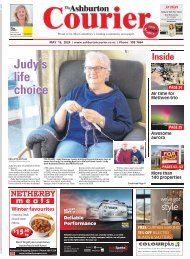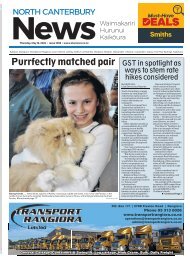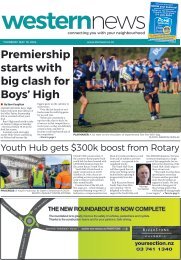You also want an ePaper? Increase the reach of your titles
YUMPU automatically turns print PDFs into web optimized ePapers that Google loves.
Feature | <strong>Magazine</strong> 45<br />
“I feel like I’m not 100 percent safe at sea because you have to really<br />
understand the elements, the weather, what you are doing, but I still have a<br />
sense of peace, a sense of unknowing, a sense of exploration.”<br />
Up painting until nearly midnight in the cabin of an ocean<br />
ship, Cora-Allan Lafaiki Twiss spreads out her day’s<br />
paintings to dry on every flat space – even her bed.<br />
The only clear surface left to sleep on is the couch, so she<br />
curls up on it for a few hours’ sleep.<br />
She’s on the Heritage Adventurer as it travels up New<br />
Zealand for two weeks visiting heritage sites explored by<br />
Captain James Cook on the Endeavour.<br />
“I wanted to visit important sites to our narrative in<br />
Aotearoa,” she says.<br />
Cora-Allan (Ngāpuhi, Ngātitumutumu, Niue: Alofi, Liku)<br />
doesn’t want to miss a moment of the experience, even if the<br />
sometimes rocky trip created some creative challenges.<br />
“I enjoy working on a boat, I’d do it again in a heartbeat.”<br />
The enjoyment of working on the water is something Cora-<br />
Allan only recently discovered. In 2021 she was selected for<br />
the Parehuia residency in Titirangi, Auckland, hosted by the<br />
McCahon House Trust.<br />
She decided, like McCahon, to take her studio to the water.<br />
So she bought a little boat and got her skipper’s licence.<br />
“The experience of being a boatie, I’m absolutely addicted<br />
to,” she says.<br />
“I feel like I’m not 100 percent safe at sea because you have<br />
to really understand the elements, the weather, what you are<br />
doing, but I still have a sense of peace, a sense of unknowing, a<br />
sense of exploration.”<br />
Her next trip, travelling up New Zealand’s coast, was<br />
“way more” than she could have expected as it has led to<br />
a first for the artist – being able to combine elements of<br />
both her Māori and Niuean whakapapa – using traditional<br />
hiapo (decorated bark cloth) from Niue and Māori painting<br />
techniques using pigments from the whenua (land) in her<br />
exhibition Encountering Aotearoa.<br />
“They have been able to collide in this show, meet in<br />
one space. The show itself heavily features the whenua, the<br />
landscape. It has been a real exploration for myself of what it<br />
means to be Māori and Niuean from the Pacific, to create and<br />
look at whenua, the place I live in, the way of experiencing it<br />
differently through this continuous trip around the coastline.”<br />
She travelled from south to north following in the footsteps<br />
of the botanists and artists on board the Endeavour during<br />
its maiden voyage in 1769, in particular Tupaia, a Tahitian<br />
navigator on the boat who had with him on the trip a young<br />
family member, Taiata.<br />
In an echo of this, Cora-Allan asked her Niuean father<br />
along, as her assistant. The pair are very close and her<br />
father often joins the family on arts residencies and<br />
research projects.<br />
“Having my dad there to accompany me but also to get his<br />
perspective of the trip was really interesting. He doesn’t come<br />
from an arts background but the knowledge of his generation<br />
living in Aotearoa allowed him to experience it differently.<br />
“It was really good to get a frame of reference from what<br />
he had learnt in school and what I had learnt.”<br />
As Cora-Allan tends to work from 5am to midnight, having<br />
someone to make her a cup of tea or just be there means a lot.<br />
“He’s a really good buddy to be honest. Just hearing his<br />
snoring in the corner is comforting. Working as an artist can<br />
be very isolating so having a whānau member on board makes<br />
it more whole.”<br />
It is also a reflection of the journey she and her father have<br />
been on. Growing up in West Auckland with four siblings in a<br />
three-bedroom house, the emphasis was on earning enough<br />
to feed the family.<br />
“I didn’t grow up in a household where art was a thing. For<br />
myself it was a very different world. My parents had never<br />
been to university – I was the first in my family to do so.”<br />
Cora-Allan forged her own path to be an artist, getting<br />
a scholarship to AUT at 17, enrolling without her family’s<br />
knowledge. Over the years as her practice has grown and her<br />
work has sold, her father has come around.<br />
“Now they’re really on board as they’re able to see the<br />
capacity of my dreams. My dad makes all my tools for my<br />
traditional hiapo practice and my sister is always there. We all<br />
kind of play roles, it’s not a singular practice, it’s one the whole<br />
family loves as they get to see one of us succeed.”<br />
Her father also created journals while on the boat,<br />
reflecting on the research he did on historical marine journals<br />
and the stories of mariners such as Sir Peter Blake.<br />
While the history shared aboard was from a Pākehā<br />
perspective, Cora-Allan and her father were able to add their<br />
knowledge to the mix.


